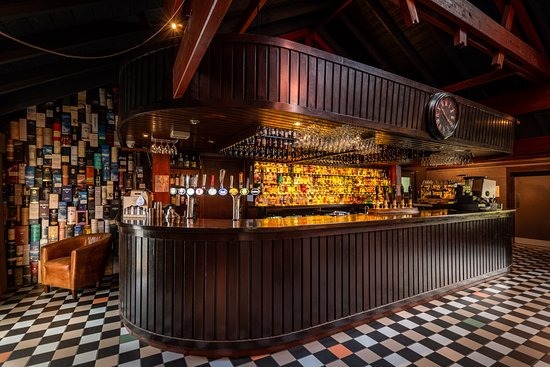Exploring the Hebrides on foot, then savoring Seumas’ Bar on Skye

The adventure unfolds from the very beginning. A clearly defined trail winds through heather just brushing the ankles, flanked by the mighty Red and Black Cuillin, their rugged features and solid gabbro bases on full display. Even shrouded in mist on this cloudy morning, they stand out as, in my view, the most captivating mountain ranges across Britain.
Yet, just ahead, nestled between the two imposing peaks, lies Sgùrr na Strì, a relatively modest 494-meter formation of compacted rock poised to rival its neighbors. Many argue that the vista from its summit is Scotland’s most breathtaking. The landscape’s ever-changing play of shadows, observed from the hill’s peak, spans across the Black Cuillin to Loch Coruisk, the Small Isles, and the Sea of the Hebrides, evoking a sense of constant motion.
I embark on the extensive journey to Sgùrr na Strì, starting from the unoccupied trailhead at the Sligachan Old Bridge car park in the heart of Skye—a journey that both begins and concludes at this point. Although there’s a popular alternative involving a 20-minute rib boat voyage (costing £18, requiring essential booking) from Elgol to Loch Coruisk, followed by a one-way, seven-mile walk, I’ve opted for the more extensive, yet free, round trip.
Though no longer in use, the iconic Sligachan Old Bridge, often captured in photographs, has played a part in elevating Skye’s popularity on Instagram in recent years. Today, the area is adorned with the delights of the season. The Sligachan River flows with vigor, the heather has shifted from amethyst to a soft violet hue, and the midges have vanished.
A haunting call from a stag echoes in my direction, and later, I catch sight of one, skittish and distant, below the rugged horn of Sgùrr nan Gillean—a mountain that prompts most visitors to reach for their cameras.
Uncommon for a lively island like Skye, this area remains relatively uncrowded, preserving the wild essence that inspired two of Britain’s renowned mountaineers. In the late 19th century, John MacKenzie, a Skye native and crofter, became Britain’s inaugural professional mountain guide. His frequent companion, Professor John Norman Collie, recognized the untapped potential of these hills. Their bond, formed in 1886, led them to conquer ten of the initial ascents of the largely uncharted Cuillins. Understanding this history adds profound depth to the hike.
Significantly, the beginning of the Sgùrr na Strì trail is marked by a sculpture honoring these pioneers. Resting side by side in the Bracadale Free Church graveyard in Struan on Skye’s western coast, these daring mountaineers shared a friendship that extended beyond their lifetimes.
Yet, more than these symbolic commemorations, their enduring legacy endures. Their exploration of Skye’s hills revealed a profound sense of purpose. Mountains transformed from daunting barriers to places offering pure and unbridled joy. Their influence animated Scotland’s most challenging peaks. Once desolate and untouched summits now saw crags and tors traversed and climbed. This sanctified the revered pursuit known as “Munro bagging” – the quest to summit all of Scotland’s 914-meter (3,000-foot) peaks.
Altogether, there are 282 Munros, and as I advance through the peatlands of Glen Sligachan, the path unfurls captivating panoramas of many of the most stunning peaks. To my left, Blà Bheinn stands, while across a scree-covered corrie to the right loom Sgùrr Dubh Mòr, Sgùrr Alasdair, and the towering Inaccessible Pinnacle. The landscape is graced with well-defined trails, but a firm grasp of map reading and the aid of a topographic GPS app on your phone are equally essential when exploring these well-traveled higher ridges.
I progress along the ridge of the glen, traversing through terrain managed by the John Muir Trust. The path grows damp, and I navigate around the bogs until I reach a divergence in the trail, marked by a substantial cairn. Suddenly, I feel inclined to veer left, drawn to the glimmering shores of Loch Scavaig, where wild campers pitch their tents along the shoreline. However, to my right, I begin to discern the winding ascent along the Druim Hain, leading to my ultimate destination. Deep down, I recognize this as the correct path, perfectly positioning me on the gently sloping ridge.
After forty minutes, passing by a small lochan and reaching the crest, Sgùrr na Strì and the jagged Black Cuillin become sharply visible.
At this stage, like many hikes in the Hebrides, the trail intermingles with scattered rock outcrops, transforming the journey into a navigation challenge as I weave my way through the jumbled boulders along a wide southwest-facing ridge toward the summit. In haste, I choose the most direct path up the burn, a decision I regret instantly given that I’m wearing trail running shoes. Nonetheless, damp feet seem a small sacrifice as I’m drawn closer to my final destination, the sun breaking through the clouds.
Finally arriving at the most breathtaking viewpoint in the Highlands, marked by a cairn seemingly perched to be swept into the sea at any moment, I pause. This is where one should linger, taking in the grandeur of the landscape as the steep vantage point offers more than just a reward for geography enthusiasts or those passionate about paleogene geology. It’s a place to pay homage to the birthplace of British mountaineering.
As the wind picks up before sunset, I turn to start the journey back down Glen Sligachan. Ahead, behind the Sligachan Hotel, Seumas’ Bar beckons, a white speck visible for approximately two hours. With a well-defined blister on my heel, I finally reach the welcoming doors. Inside, the pub is a gathering place for hikers to quench their thirst and share their experiences after long days in the hills, much like MacKenzie and Collie did, exchanging their personal tales of devotion and reverence for Skye’s mountains.


